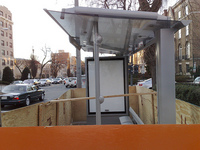WMATA’s $529 million economic stimulus wish list
A lot of the recent discussion about “shovel-ready” stimulus plans has centered around the idea that highway and road projects are inherently “shovel-ready”, while transit projects like new light rail systems would happen too slowly for the stimulus to do any good. Some say that even though light rail may be a good investment, we wouldn’t get the win-win of economic stimulus as well in a short enough time frame. Well, WMATA has its own list of “shovel-ready” projects.
At Friday’s Board of Directors meeting WMATA General Manager John Catoe presented a list of $529 million in economic stimulus projects that meet the American Public Transit Association’s recommended guidelines. According to APTA, projects should be implementable within 90 days, eligible for Federal funding, and projects that would not happen during the current fiscal year without funding help.
Metro categorizes the requests as follows:
Vehicles and parts: $120M for buses, railcar truck parts, and miscellaneous parts. WMATA states that the purchases will support the American auto industry, especially through the purchase of bus parts like seats, windows, doors, and transmissions.
Maintenance facilities: $177M for repairing, replacing or expanding bus garages and railcar maintenance facilities. WMATA says that the improvements will help employ workers in the construction industry that has been hit hard by the economic downturn.
Passenger facilities: $167M for replacing platforms, installing station canopies, improving credit card readers, etc. Just like with the maintenance facilities, local construction companies would get some business.
Safety and security: $4.2M for emergency tunnel evacuation cars and expanding the “chemical sensors detection system”.
Maintenance and repair equipment: $43M for cranes, cars for carrying rails and equipment, and de-icing equipment.
Operations systems: $11M for fare collection equipment, signage and “grout pads” which are an installation method used to improve the strength and stability of vertical columns installed on concrete surfaces. By eliminating warping of the base plate, a grout pad stiffens a column installed by bolting a flange plate to studs embedded in concrete. See this UF research paper (big PDF) conducted for the Florida DOT for more on grout pads.
Information technology: $12M for hardware and software to improve maintenance efficiency, monitor network traffic and provide disaster recovery.
There’s a lot of good stuff on that list. WMATA hasn’t prioritized it yet, though. What if, as is likely, WMATA doesn’t get all of the funds they requested? What would be the highest priority, and what can wait? As it stands now, none of these projects will be completed this year without external funding, so we can’t just say “it’s all important”.
What do you think? What appeals to you from this list?

